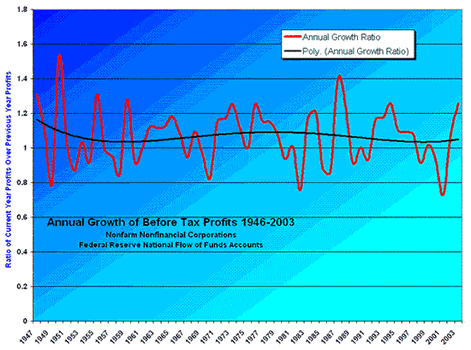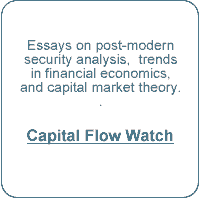 Stock Valuation: Discounted Cash Flow
Stock Valuation: Discounted Cash Flow
Equity Values: Discounted Cash Flow
Ballyhoo and Earnings Growth
The next graph shows fluctuations in the annual changes in pre-tax U.S. corporate profits against a polynomial trend line.
 There was nothing special about earnings growth in the 1990s.
There was nothing special about earnings growth in the 1990s.The graph shows that there has been no real change in the basic rate of earnings growth over half a century.
Ballyhoo about technological progress and financial efficiency did not translate into exceptional average earnings growth.
- Fast growth in the years following World War II had abated by the 1950s.
- The average growth rate of 5.3% over the half-century can be explained entirely by growth of population and inflation.
- The slight rise in the trend during the 1970s was caused by inflation brought on by Lyndon Johnson's Great Society programs, the Vietnam War, and Nixon's abandonment of the gold standard.
Wall Street ballyhoo about the benefits of technological progress and financial efficiency does not seem to relate to the actual growth of profits, other than increasing risk to individual companies that may be swept away or brought to the fore by change.
A Reasonable Discount Rate
The interest rate, 'I', used to discount the projected dividend stream should be the same long-term rate used in measuring equity risk on a cash basis: that is, 120% of the current yield of triple-A corporate bonds.
Unlike bonds, equities do not represent a contractual obligation to pay anything to shareholders.
Since, unlike bonds, equities do not represent contractual obligations to pay dividends and since stockholders stand after bondholders in receiving a share of corporate cash, and since dividend payout rates are subject to policy change and are more volatile than bond payments, it is reasonable to demand a premium for dividend yields over bond yields.
The amount of this premium can be reasonably based on historical requirements of individual investors prior to the 1960s — before the advent of workers' capitalism — as discussed in the lesson on yield based valuation.
Equity Risk, Considering Growth and Interest Rates
Since we cannot know what the future will bring, it is impossible to say whether John Burr William's formula applied to the entire market produces too optimistic or too pessimistic a result.
If we are indeed at the End of the Great Age, expectations of normal earnings growth may be optimistic.
If we are indeed at the End of the Great Age and if total corporate profits continue to be correlated with population growth, then using historical profit growth rates to project future dividends may give results that are too optimistic.
On the other hand, if there is a revolution in corporate governance, a general renunciation of the buyback fallacies, a Great Awakening that leads to renewed appreciation of dividends, and a substitution of the asset-lite movement by directed investment policy that considers long-term national goals, then using current dividends as a basis may be too pessimistic.
In any event, the Five Horsemen of the Investment Apocalypse will continue to guarantee that the future is unknowable, making this measure of equity risk at least as useful as any other.
Before proceeding, check your progress:
Self-Test
During the 1990s, the rate of growth of pre-tax U.S. corporate profits was :
|
|
During the 1990s, technological progress resulted in:
|
|
Compared to the interest on bonds, dividends on common stock have:
|

